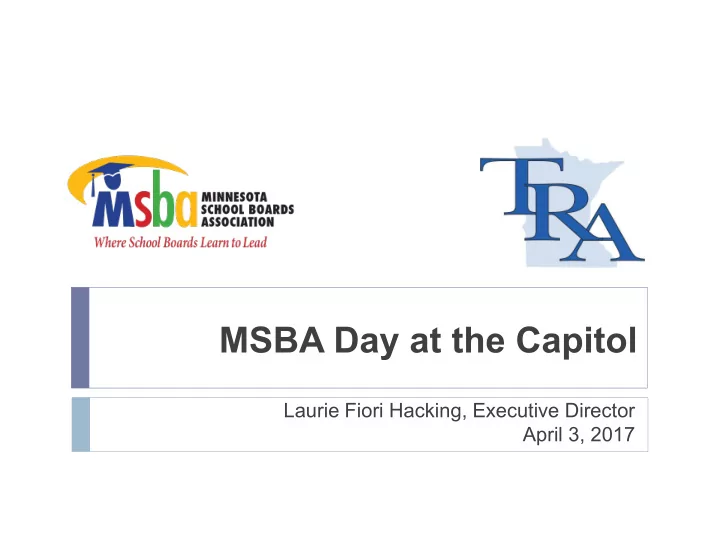

MSBA Day at the Capitol Laurie Fiori Hacking, Executive Director April 3, 2017
TRA’s membership and mission Serving teachers for over 100 years – five generations of educators TRA membership – nearly 190,000 o 80,530 active teachers o 80,530 active teachers o 63,503 retired public school educators, state college faculty o 13,680 deferred, vested members o 31,850 deferred, non-vested members TRA assets and benefits o $20 billion in assets o $1.7 billion in annual payments which benefit local economies and generate tax revenue TRA’s mission: Retirement security for Minnesota teachers Support state’s education system by attracting and retaining teachers 2
Pensions help recruit and retain teachers Teacher shortages increasing – studies show pensions help attract and retain experienced teachers Recruitment : Among workers under age 40, 63% say offer of defined benefit (DB) pension is important in accepting the job, up from 28% just two years before. (Towers Watson, 2012) Retention : Three-fourths of new hires say DB pension is compelling reason to stay on the job. Teacher effectiveness and productivity improve with experience. (Towers Watson, 2012 and National Bureau of Economic Research, 2006; Milanowski and Odden, 2007) Teacher turnover costs high – recruitment, hiring, orientation, productivity loss. (Alliance for Excellent Education, 2005 and National Institute on Retirement Security, 2011) Teacher pay gap partly filled by pensions. 2016 study shows teacher salaries lag those of comparably educated by 17%. (Allegretto and Mishel, 2016) 3
TRA revenue sources: Investment returns provide most pension funding TRA Comprehensive Annual Financial Reports, 1990-2016 National public pension average: (Source: National Association of State Retirement Administrators, Oct. 2016) 4
State Board of Investment Calendar year returns Periods ending 12/31/16 12% PERIODS State MEDIAN ENDING Board of PUBLIC 9.8% 9.8% 12/31/16 Investment FUND 10% 8.9% 1 year 7.6% 7.5% 8.2% 7.6% 8% 7.4% 3 years 5.3% 4.6% 6.1% 5 years 9.8% 8.3% 6% 5.3% 10 years 6.1% 5.2% 4% 20 years 7.4% 6.9% 25 years 8.2% 7.8% 2% 30 years 8.9% 8.3% 0% 1 Yr 3 Yrs 5 Yrs 10 Yrs 20 Yrs 25 Yrs 30 Yrs 35 Yrs Source: NASRA and Callan Associates 5
Why TRA funding legislation is needed? Effects of 2015 experience study 2015 experience study evaluated all actuarial assumptions and recommended: Lower investment assumption from 8.5% to 8%, adds to costs and lowers funded ratio. Updated mortality table – members and retirees are living longer – on average an extra two years , adds significantly to costs. TRA board proposal (SF 930/ HF 722) addresses experience study: TRA board built support among stakeholders (actives, retirees, employers) and recommended a balanced package of benefit cuts and contribution increases to improve TRA’s long-term funded status. Proposal requests state aid to offset increased costs to school districts. 6
TRA 2017 legislative proposal Portion of proposal borne by Retirees each group* Reduce COLA from 2% to 1% for 5 years, o 1.5% thereafter, eliminate 2.5% COLA trigger Active teachers Actives Reduce future COLA from 2% to 1.5%, o 27% eliminate 2.5% COLA trigger Employers Members 46% 54% → COLA savings equal 2.66% of pay which is equivalent to $124 million annually or Retirees $1.5 billion over TRA’s projection period 27% Employers Increase contribution rate from 7.5% to o 9.5%, phased over 4 years (0.5% per year) * Based on present value of contributions and Offset by state pension aid through o benefit cuts over 30 years. pension adjustment mechanism in school Source: TRA Actuary aid formula 7
TRA 2017 legislative proposal: State pension aid Costs for school Costs for school Aid in TRA districts/charters districts/charters Governor’s rate (assuming 0%/ yr (assuming 2.5%/ yr Annual shortage budget payroll growth) payroll growth) FY18 8.0% $21.6 million $22.7 million $21.6 million $0 – 1.1 million FY19 8.5% $43.2 million $46.5 million $43.1 million $0.1 – 3.4 million FY20 9.0% $64.8 million $71.5 million $43.1 million $21.7 – 28.4 million FY21 9.5% $86.4 million $97.6 million $43.1 million $43.3 – 54.5 million Other TRA package elements: Extend amortization period to 30 years Require employer contributions on salaries of re-employed retirees 8
TRA financial status: Positive impact of 2017 proposal TRA projected funded ratio* 100% 89% 90% With proposal 80% 70% 60% 51% Without proposal 50% 40% 30% 20% 10% 0% 2015 2020 2025 2030 2035 2040 2045 With proposal Without proposal * Assumes investment assumption of 7.5% for five years, 8% thereafter. 9
Legislative proposals Governor’s budget proposal includes: State funding through Pension Adjustment Revenue formula (part of school aid formula) would offset pension costs in first two years, but only partially offset in FY 2020-21. Aid capped is in third and fourth year. Legislative Commission on Pensions and Retirement – other benefit cut options being considered: Raise full-benefit normal retirement age from 66 to 67 Increase the minimum early retirement age from 55 to 62 Steepen early retirement penalties, making it more difficult to retire early Lower benefit accrual formula from 1.9% to 1.7% for each year of service, lowering benefits for members retiring in the future by over 10% Remove incentive for younger deferred members who quit teaching to leave their contributions with TRA Lower the COLA from 2% to 1% permanently 10
TRA contribution rate history For most of TRA history employer rate has been higher than employee rate. Employer rate 10% 8% 6% 4% Employee rate 2% 0% 11
Employee contribution rates in MN higher, employer rates in MN lower Employee Employer Contribution rates in adjacent states 14 12.9% Employee Employer 12 North Dakota 3% * 12.26% ** General 10 North Dakota 11.75% 12.75% 7.5% 7.5% Teachers 8 South Dakota 6% 6% 6.0% 6 Wisconsin 6.8% 6.8% 4 Iowa 5.95% 8.93% 2 MN TRA 7.5% 7.5% 0 TRA US public plan median *ND employee contribution rate is 7% in statute, but employer picks up 4% of that rate. Source: NASRA FY2016 for Social Security-covered plans **ND employer rate includes 1.14% contribution to employee health care savings accounts and 4% employer pickup of employee rate. 12
Recommend
More recommend